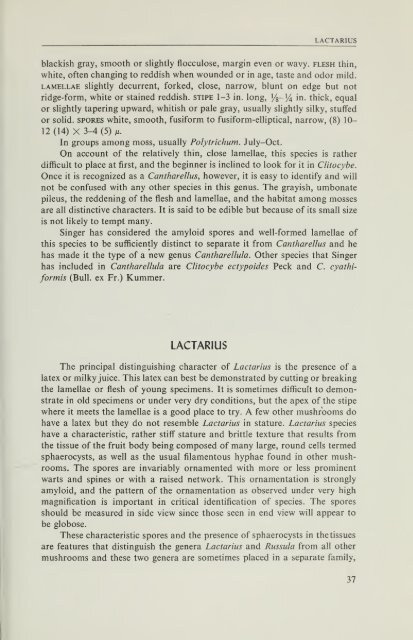Edible and poisonous mushrooms of Canada
Edible and poisonous mushrooms of Canada
Edible and poisonous mushrooms of Canada
You also want an ePaper? Increase the reach of your titles
YUMPU automatically turns print PDFs into web optimized ePapers that Google loves.
LACTARIUS<br />
blackish gray, smooth or sHghtly flocculose, margin even or wavy, flesh thin,<br />
white, <strong>of</strong>ten changing to reddish when wounded or in age, taste <strong>and</strong> odor mild.<br />
LAMELLAE slightly dccurrcnt, forked, close, narrow, blunt on edge but not<br />
ridge-form, white or stained reddish, stipe 1-3 in. long, Ys-Ya in. thick, equal<br />
or sHghtly tapering upward, whitish or pale gray, usually slightly silky, stuffed<br />
or sohd. SPORES white, smooth, fusiform to fusiform-elliptical, narrow, (8) 10-<br />
12 (14) X 3-4 (5) M.<br />
In groups among moss, usually Polytrichum. July-Oct.<br />
On account <strong>of</strong> the relatively thin, close lamellae, this species is rather<br />
difficult to place at first, <strong>and</strong> the beginner is inclined to look for it in Clitocybe.<br />
Once it is recognized as a Cantharellus, however, it is easy to identify <strong>and</strong> will<br />
not be confused with any other species in this genus. The grayish, umbonate<br />
pileus, the reddening <strong>of</strong> the flesh <strong>and</strong> lamellae, <strong>and</strong> the habitat among mosses<br />
are all distinctive characters. It is said to be edible but because <strong>of</strong> its small size<br />
is not Hkely to tempt many.<br />
Singer has considered the amyloid spores <strong>and</strong> well-formed lamellae <strong>of</strong><br />
this species to be sufficiently distinct to separate it from Cantharellus <strong>and</strong> he<br />
has made it the type <strong>of</strong> a new genus Cantharellula. Other species that Singer<br />
has included in Cantharellula are Clitocybe ectypoides Peck <strong>and</strong> C. cyathiformis<br />
(Bull, ex Fr.) Kummer.<br />
LACTARIUS<br />
The principal distinguishing character <strong>of</strong> Lactarius is the presence <strong>of</strong> a<br />
latex or milky juice. This latex can best be demonstrated by cutting or breaking<br />
the lamellae or flesh <strong>of</strong> young specimens. It is sometimes difficult to demon-<br />
strate in old specimens or under very dry conditions, but the apex <strong>of</strong> the stipe<br />
where it meets the lamellae is a good place to try. A few other <strong>mushrooms</strong> do<br />
have a latex but they do not resemble Lactarius in stature. Lactarius species<br />
have a characteristic, rather stiff stature <strong>and</strong> brittle texture that results from<br />
the tissue <strong>of</strong> the fruit body being composed <strong>of</strong> many large, round cells termed<br />
sphaerocysts, as well as the usual filamentous hyphae found in other <strong>mushrooms</strong>.<br />
The spores are invariably ornamented with more or less prominent<br />
warts <strong>and</strong> spines or with a raised network. This ornamentation is strongly<br />
amyloid, <strong>and</strong> the pattern <strong>of</strong> the ornamentation as observed under very high<br />
magnification is important in critical identification <strong>of</strong> species. The spores<br />
should be measured in side view since those seen in end view will appear to<br />
be globose.<br />
These characteristic spores <strong>and</strong> the presence <strong>of</strong> sphaerocysts in the tissues<br />
are features that distinguish the genera Lactarius <strong>and</strong> Russula from all other<br />
<strong>mushrooms</strong> <strong>and</strong> these two genera are sometimes placed in a separate family,<br />
37

















